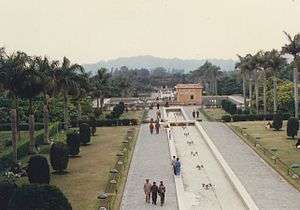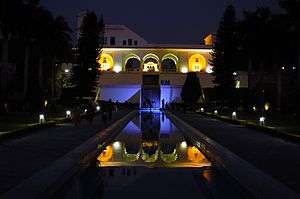Pinjore Gardens
Coordinates: 30°47′33″N 76°54′44″E / 30.79250°N 76.91222°E

Pinjore Gardens (also known as Pinjor Gardens or Yadavindra Gardens) is located in Pinjore, Panchkula district in the Indian state of Haryana. It is an example of the Mughal Gardens style, and was built by Patiala Dynasty Rulers.
Location
The garden is in the village of Pinjore lie 22 km from Chandigarh on the Ambala-Shimla road. Pinjore, where the Bhima Devi Temple Complex is located, is approachable by road, rail and air from all parts of the country. It is well connected with Chandigarh, which is the capital of both Haryana and Punjab, India states, at a road distance of 20 kilometres (12 mi). Chandigarh is a Union Territory administered by the Government of India. It is 5 kilometres (3.1 mi) from Kalka, on the road to Shimla.
History
It was created in the 17th century by architect Nawab Fidai Khan during the early reign of his foster brother Aurangzeb (r. 1658-1707).. In recent times, it has been renamed as 'Yadavindra Garden' in the memory of Maharaja Yadavindra Singh former of the princely state of Patiala.[7] After it was initially built by Fidai Khan, the garden was refurbished by Yadevendra Singh and restored to its former spledour, since it had grown into a wild jungle after initially built due to long years of neglect.[12]

C.M. Villiers-Stuart, who resided in the gardens for a time, included a description in her book on "Gardens of the Great Mughals" (1913). She wrote:

"A quaint story still survives, how, when at length the work was finished, and Fadai came in state to spend his first summer there, his enjoyment of the garden and its beauties was short-lived; for the Rajas quickly frightened him away. In the districts round Pinjor, and in fact all along the foot of the Himalayas, occasional cases of goitre are to be seen; so from far and wide these poor people were collected by the wily Brahmins, and produced as the ordinary inhabitants of the place. The gardeners all suffered from goitre; every coolie had this dreadful complaint; even the countrywomen carrying up the big flat baskets of fruits and flowers to the zenana terraces were equally disfigured.
The ladies of the harem naturally were horrified; it was bad enough to be brought into these wild outlandish jungles, without this new and added terror. For the poor coolie women, well instructed beforehand, had told how the air and water of Pinjor caused this disease, which no one who lived there long ever escaped. A panic reigned in the zenana; its inmates implored to be removed at once from such a danger; and finally, Fadai Khan had to give way, and take his ladies to some other place less threatening to their beauty.
Had it been the terrible Emperor himself instead of his foster-brother, the cunning Rajas would have met their match. But Fadai Khan, thoroughly deceived, rarely came back to visit his lovely gardens, and the Rajas and their fields were left in peace for a time."
Architecture
The garden has been laid in seven terraces, with the main gate of the garden opening into the highest first terrace, which has a palace built in Rajasthani–Mughal style. It is called the “Shish Mahal” (palace of glass), which is adjoined by a romantic "Hawa Mahal" (airy Palace). The second terrace with arched doorways has the "Rang Mahal" (painted palace). The third terrace has cypress trees and flowerbeds leading to dense groves of fruit trees. The next terrace has the "Jal Mahal" (palace of water) with a square fountain bed and a platform to relax. Fountains and tree groves are provided in the next terrace. The lowermost terrace has an open-air theatre, which is designed as a disc-like structure.
Pinjore Garden Site Museum
The garden and the temple complex laid in an open-air museum, set up by Haryana State Directorate of Archaeology & Museums, are integrated through well-laid-out and well-drained pathways to remove any water logging. The whole complex has been beautifully illuminated.
Pinjore Garden Heritage Train
A restored heritage train has been introduced to visit all the monuments and the gardens in the complex.
Pinjore Zoo
A zoo adjoins the gardens.
Pinjore Garden Festivals
Special festivals such as the Pinjore Baisakhi festival (spring festival) in April and the Pinjore Mango festival in June and July are major attractions at the gardens.
References
External links
| Wikimedia Commons has media related to Pinjore Gardens. |
- Pinjore Gardens near Chandigarh
- Online text: Gardens of the Great Mughals by C.M. Villiers Stuart
- Pinjore Gardens
- The Herbert Offen Research Collection of the Phillips Library at the Peabody Essex Museum
- Pinjore garden Jal Mahal
